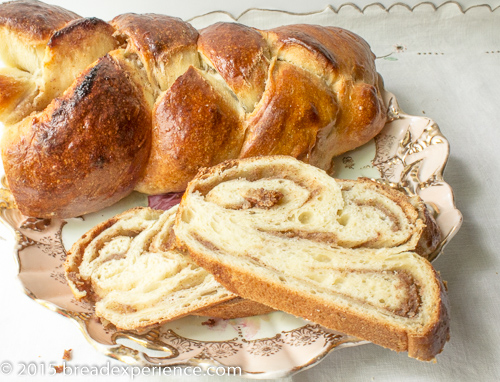In this roundup, you’ll find some of my favorite Easter Breads from around the world, including Italian Easter Bread, English Hot Cross Buns, Romanian Easter Bread and some other festive breads.

Easter celebrates the resurrection of Christ, but it also celebrates fertility, and the season of renewal. Nature is reborn after the death of winter, and the Christian festival has evolved from pagan celebrations without ever quite eliminating them.” – Bernard Dupaigne, The History of Bread.
Ciambella Mandorlata – Italian Easter Bread – Ciambella Mandorlata, an Italian Easter bread that originated in Bologna in the Emilia Romagna region, is typically baked in the shape of a ring, to represent the unity of the family.
Ciambella is made with an enriched yeast dough and has a soft brioche-like texture. It is topped with crunchy sweet spiced almonds, which in my opinion, is the best part.
Chocolate Cinnamon Babka – Babka is a rich, yeasted cross between bread and coffee cake. The name is derived from the Russian baba, which means grandmother. The American version is usually formed as a twisted loaf, but I decided to try the Israeli version, known as kranz cake, because it looked really cool.
Chocolate Bunny Bear Bread – This Chocolate Easter Bunny Bread is my take on the chocolate bunny typically found in Easter baskets. I seem to be better at shaping bears than bunnies so this one looks more like a bear than a bunny.
English Hot Cross Buns – Traditional English Hot Cross Buns made with an overnight sponge, candied orange peel and a crossing paste made of flour.
Italian Easter Braids – Italian Easter Braids are made by twisting and looping the braids to form a circle just big enough to hold an Easter egg in the middle.
Nazook Flaky Walnut Pastry Rolls – Nazook, also known as Nazukeh, and Gata, is a flaky and slightly sweet walnut pastry rolled around a streusel-like mixture of crushed walnuts, melted butter and flour. It is flavored with spices such as cardamom, cinnamon, and vanilla. Some versions also include grated nutmeg.
Nazook is common in Armenia, Assyria, (Iraq, Iran, Turkey, Syria) and other countries around the world. Not surprisingly, it is popular all year round, particularly with tourists, but is traditionally baked for Easter in some areas and eaten through Ascension, some 40 days later.
Sourdough Hot Cross Buns with Icing – These sourdough hot cross buns are made with an overnight sponge and filled with candied orange peel, currants or raisins, and delicious spices. After baking, the buns are glazed with a honey/orange glaze.
I used icing for the crosses instead of a paste because I wanted something sweet to round out the tangy flavor of the candied orange peel and honey/orange glaze. However, feel free to go with the traditional flour crossing paste, if desired.
Sourdough Romanian Easter Bread – The traditional version of this braid is typically eaten on Easter; however, you can enjoy this festive bread anytime.
This swirled bread features a beautiful three-strand braid, but what makes it extra special is that each braid is filled with a paste of finely crushed almonds, cinnamon and lemon zest. It makes a delightful treat for any special occasion or just because.
Symbolic Easter Breads
For Easter Sunday, Orthodox Christians dye and decorate eggs. On Holy Thursday to commemorate the Last Supper, when Christ shared bread with his disciples, they prepare in absolute silence a brioche or egg bread called Koulitch. On the Saturday night of Resurrection, they walk in procession to church with a basket of eggs, holding a candle in one hand, and the bread in the other. They exchange a kiss and ask each other’s forgiveness for any offense they might have committed against one another, as a token of peace for the future.” —The History of Bread, Bernard Dupaigne, Harry N. [Abrams: New York] 1999 (p. 139)
Hot Cross Buns are a traditional treat at Easter
These small yeasted buns have been popular in England since medieval times. Small breads, enriched with eggs, currants and raisins and spiced with nutmeg and cinnamon, were served with wine at the end of a feast. During the Middle Ages, it was common practice to mark loaves with a deep cross to ward off evil spirits, and although the custom was abandoned after the Reformation, the buns made for Good Friday continued the custom for this most significant of religious days. Some bakers continue to bake their own hot cross buns only during Lent.” —BREAD: the breads of the world and how to bake them at home, Christine Ingram and Jennie Shapter, [Hermes House: London] 2006 (p.47, 48)
Kulich is the most famous Russian Easter bread
The tall narrow shape is Slavic and of great antiquity… The Kulich is based on a baba dough, with more sugar, plus additions of candied peel, almonds, raisins, and saffron. The bulging top is iced and decorated, usually with Cyrillic letters standing for ‘Christ is risen’. Traditionally the kulich is taken to be blessed at midnight mass on the eve of Easter Sunday. In some families it replaces bread for the entire Holy Week. It is served with Paskha, a sweetened confection based on curd cheese.” —Oxford Companion to Food, Alan Davidson [Oxford University Press:Oxford] 1999 (p. 266)

Leave a Reply